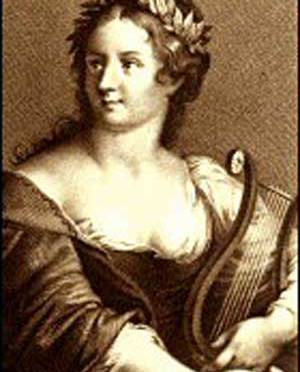Gaspara Stampa was born in 1523 to a bourgeois family. Her parents were known for hosting cultural salons, and they ensured that Gaspara and her siblings were educated in Latin, literature, and music.
She became an excellent lute-player and singer, as well as an exceptional lyric poet. When she began to host her own cultural salons, she often performed her own work. Modern Western poetry was born from the Medieval culture of performance; poets would sing their own compositions, since most people were illiterate. However, in the later middle ages, there was a shift towards writing and reading rather than singing and listening. Gaspara was one of the last poets who was equally skilled at writing and performing, and she quickly became a much-admired figure in the cultural circles of her native Venice.
During this period, Gaspara met and fell in love with Collaltino di Collalto, an aristocratic soldier. Although they had a sexual relationship, he was often away on military business and never felt as passionately about her as she did about him. The vast majority of her poems were devoted to Collaltino, often declaring her love while lamenting his lack of commitment. So far, so cliché. But Gaspara’s work becomes extraordinary for two reasons. First, she described an extramarital sexual relationship with a frankness that is nothing short of radical. Second, the entire tradition of Italian lyric poetry was designed for men writing about women. The general consensus at the time was that Petrarch (1307-1374) was the greatest Italian lyric poet, and that a good poet should imitate him as closely as possible. Petrarch’s most famous work, Il Canzoniere, was a collection of poetry focused on his unrequited love for a married lady. So what was a woman in a sexual relationship to do with a tradition designed for men in chaste relationships?
Gaspara managed to use Petrarchan vocabulary and imagery to cover totally different subject matter, as we see in this particularly bold poem:
O Notte, a me più chiara e più beata
che i più beati giorni, e i più chiari…
tu de le gioie mie sola sei stata
fida ministra, tu tutti gli amari
de la mia vita hai fatto dolci e cari,
resomi in braccia lui, che m’ha legato...
“Oh night, to me brighter and more blessed than the most blessed and brightest of days…you alone have been the faithful minister of all my joys, you have made all the bitterness in my life sweet and dear, by placing him into the arms of he who bound me…”
Gaspara uses the ultra-refined Petrarchan vocabulary to describe an occasion that Petrarch would never have dreamed of: an illicit night-time encounter. Gaspara brilliantly plays with the limitations of this vocabulary. Petrarch loved to describe the passing of hours and the day and night, and Gaspara picks up on this. But whereas Petrarch enjoyed the night because he could freely let out his heartbroken sighs, Gaspara seems to be having a lot more fun. She even uses one of Petrarch’s favourite words to describe his lovesickness, “legato”, or “bound”. But while Petrarch is merely bound by the metaphorical chains of his loving devotion, Gaspara is literally embraced within her lover’s arms.
Unfortunately, Gaspara’s relationship with Collaltino did not last much longer, leading to a collection of heartbroken poems. It may seem paradoxical that a woman now considered a feminist icon spent most of her career heartbroken over a man; but it is rather satisfying to note that nowadays Collaltino is rarely mentioned outside the context of Gaspara’s work. And furthermore, Gaspara then did something quite astonishing. She started writing love poetry about someone else. At the time, when the expectation was that lyric poets would remain true to their beloved forever, this is as shocking as a monk turning their back on God and enjoying la dolce vita. The fact that it was a woman writing about having multiple lovers was even more amazing. Although the someone else, Bartolomeo Zen, received only a few of Gaspara’s poems, the fact that she wrote for a second beloved at all shows just how radical her approach to lyric poetry was.
In the post-Collaltino period, Gaspara may have worked as a courtesan. Sadly, though unsurprisingly, the vast majority of scholarship around Gaspara’s work focused on trying to determine if this was the case. Until the feminist wave of academia in the late 20th century, it was simply assumed that if the woman had been a whore, there was no way her poems could be any good; if, however, the lady had simply been a salon hostess, then her work was worthy of serious study. Thankfully, we now realise that, first, we will probably never know for sure if she was a sex worker or not; and, second, it makes no difference to what an exceptionally talented, creative and original woman she was.


Reblogged this on Lenora's Culture Center and Foray into History.